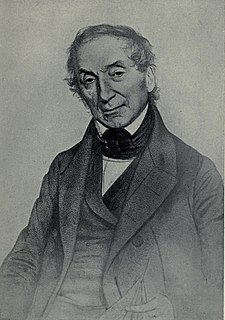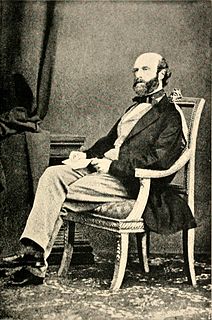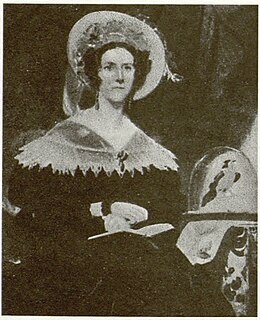Related Research Articles

John Edward Gray, FRS was a British zoologist. He was the elder brother of zoologist George Robert Gray and son of the pharmacologist and botanist Samuel Frederick Gray (1766–1828). The standard author abbreviation J.E.Gray is used to indicate this person as the author when citing a botanical name. The same is used for a zoological name.

John George Children FRS FRSE FLS PRES was a British chemist, mineralogist and zoologist. He invented a method to extract silver from ore without the need for mercury. He was a friend of Sir Humphry Davy, who helped him secure a controversial appointment to a post in the British Museum. Children was also the founding president of the Royal Entomological Society.

Nathaniel Wolff Wallich FRS FRSE was a surgeon and botanist of Danish origin who worked in India, initially in the Danish settlement near Calcutta and later for the Danish East India Company and the British East India Company. He was involved in the early development of the Calcutta Botanical Garden, describing many new plant species and developing a large herbarium collection which was distributed to collections in Europe. Several of the plants that he collected were named after him.

Alexander Henry Haliday was an Irish entomologist. He is primarily known for his work on Hymenoptera, Diptera, and Thysanoptera, but worked on all insect orders and on many aspects of entomology.

William Thompson was an Irish naturalist celebrated for his founding studies of the natural history of Ireland, especially in ornithology and marine biology. Thompson published numerous notes on the distribution, breeding, eggs, habitat, song, plumage, behaviour, nesting and food of birds. These formed the basis of his four-volume The Natural History of Ireland, and were much used by contemporary and later authors such as Francis Orpen Morris.

Andrew Dickson Murray FRSE FRPSE FLS was a Scottish lawyer, botanist, zoologist and entomologist. Murray studied insects which caused crop damage, specialising in the Coleoptera. In botany, he specialised in the Coniferae, in particular the Pacific rim conifer species.

William Henry Harvey, FRS FLS was an Irish botanist and phycologist who specialised in algae.

Orcadians are the indigenous inhabitants of the Orkney islands of Scotland. Historically, they are descended from the Picts, Norse, and Scots.

George Johnston was a Scottish physician and naturalist.

John Ralfs was an English botanist. Born in Millbrook, near Southampton, he was the second son of Samuel Ralfs, a yeoman of an old family in Hampshire. He has been commemorated in the names of many plant groups and taxa at many levels.

Dr Robert Kaye Greville FRSE FLS LLD was an English mycologist, bryologist, and botanist. He was an accomplished artist and illustrator of natural history. In addition to art and science he was interested in causes like abolitionism, capital punishment, keeping Sunday special and the temperance movement. He has a mountain in Queensland named after him.
Joseph Whittaker was a British botanist who visited South Australia in 1839. Whittaker has 300 plants from that trip in Kew Gardens and a large collection of pressed British plants in Derby Museum and Art Gallery.
The Botanical Society of Scotland (BSS) is the national learned society for botanists of Scotland. The Society's aims are to advance knowledge and appreciation of flowering and cryptogamic plants, algae and fungi. The Society's activities include lectures, symposia, field excursions, field projects and an annual Scottish Botanist's Conference, held jointly with the Botanical Society of Britain and Ireland for exchange of information between botanists working in different areas. Its publications include a twice-yearly newsletter, BSS News, and a scientific journal, Plant Ecology & Diversity. The society is closely linked to the Royal Botanic Garden Edinburgh and the Scottish universities.

Anna Maria Walker and her husband Colonel George Warren Walker (1778–1843) were Scottish botanists in Ceylon who made extensive collections of plants between 1830 and 1838. Several species of ferns and orchids were named after them by Sir William Jackson Hooker with whom they corresponded. They also corresponded with and collaborated with other botanists in the region such as Robert Wight. Anna Maria was also an excellent botanical artist who illustrated many species of orchids. Plant species named after them include Vanilla walkeriae, Liparis walkeriae and Thrixspermum walkeri.
John Drew Salmon was an English ornithologist and botanist.

Christian Ramsay, Countess of Dalhousie informally Lady Dalhousie, néeBroun; was a Scottish botanist and natural historian. She married George Ramsay, 9th Earl of Dalhousie and travelled with him when he was appointed Lieutenant Governor of Nova Scotia, Governor General of Canada and Commander in Chief of the Indian Army. While travelling, she collected and catalogued many species of plants, presented scientific papers to societies and donated many collections to different botanical groups.

Richard Parnell FRSE MWS was a British physician as well as an amateur zoologist, ichthyologist and agrostologist. He gives his name to Parnell's moustached bat. The grass Parnelli is also named after him.
William Laughton was a Scottish minister of the Free Church of Scotland who served as Moderator of the General Assembly to the Free Church 1881/82.
James Stirton was a Scottish physician and one of Scotland's leading experts on cryptogamic botany. His investigations in bryology and lichenology earned him a world-wide reputation.

Stromness Museum is a small independent museum in the town of Stromness in Orkney, Scotland focusing on the town's connections to maritime and natural history.
References
- ↑ Sir Walter Elliot, 'List of Field Clubs, being a continuation of the Address delivered December 1870', in Transactions of the Edinburgh Botanical Society, Volume XI, 1873, 249
- ↑ Diarmid A Finnegan, Natural History Societies and Civic Culture in Victorian Scotland, Taylor & Francis, 2015
- ↑ 'Orkney Natural History Society', Annals of Natural History, Vol. 5, 29, April 1840
- ↑ 'Orkney Natural History Society', Annals of Natural History, Vol. 5, 29, April 1840
- ↑ Sir Walter Elliot, List of Field Clubs, Transactions of the Botanical Society, Vol. 11, 1872, p. 249
- ↑ George Anderson, Peter Anderson, 'Guide to the Highlands and Islands of Scotland including Orkney and Zetland', (Edinburgh), 1842, p. 646
- ↑ E J Lowe, The Conchology of Nottingham, London, 1853, titlepage
- ↑ A History of Stromness Museum https://www.stromnessmuseum.org.uk/history
- ↑ 'Orkney Natural History Society', Annals of Natural History, Vol. 5, 29, April 1840
- ↑ A History of Stromness Museum https://www.stromnessmuseum.org.uk/history